
01. Birthplace of Kodokan Judo
Eisho-ji, 5 chome 1-2, Higashi-ueno
In 1882, it was here in the study of Eisho-ji Temple in Shitaya, that Kano Jigoro (1860-1938), the founder of Kodokan Judo, started training with his friends and followers.
This temple's study is regarded as the birthplace of Kodokan Judo. It has gained international popularity and has spread to various countries around the world. The study first used as a training hall, was just 12 tatami mats big and the first year saw just 9 followers join.
In the summer of 1882, Kano Jigoro obtained the cooperation of Asa Shunpo (1837-1914), the chief priest of Eisho-ji Temple, and constructed a temporary drill hall. The drill hall was the size of 12 tatami mats and was situated in the vacant area next to the temple entrance. In 1883, the hall was relocated to Kanda in Chiyoda City.
In 1558, Eisho-ji Temple was first established in Shitaya Choja Machi, by the Jodo sect of Buddhism and was moved to its current position here in 1637. In 1923, the temple burnt down in the fires of the Great Kanto Earthquake.
In October 1968, a monument made of stone, was erected by Kodokan in the former position of the drill hall, with the inscription "Birthplace of Kodokan Judo" to commemorate the 30th anniversary of the passing of Kano Jigoro.
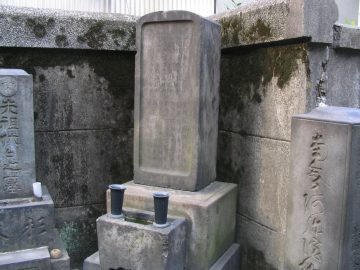
02. Tomb of Three Generations of the Saito Family
Metropolitan Historic Site
Houzen-ji, 6 chome 17-3, Higashi-ueno
In the Saito family used to rule Six city blocks, the central block of which was Kanda-Kiji-Machi. Three generation of the Saito family: Choshu, his son Agatamaro, and his grandson Gesshin, surveyed the topography of Edo and completed the publication of "Edo Meisho Zue" (illustrated Map of Sightseeing areas in Edo). The illustrated publication consists of 7 scrolls and 20 volumes which explains social customs and manners, events, and sightseeing areas. It was illustrated by Hasegawa Settan and his son Hasegawa Settei. Illustrations and explanations were made based upon field surveys, so the publication is one of the most important references for providing information on the life and scenes of Edo. Gesshin also published "Toto Saijiki" and "Buko Nenpyo" also indispensable reference books.
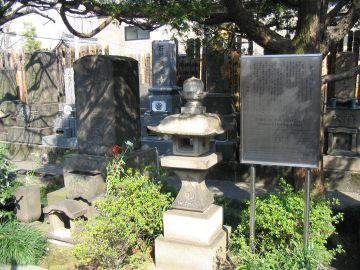
03. Tomb of Ino Tadataka
National Historic Site
Genku-ji Temple, 6 chome 18, Higashi-ueno
Ino Tadataka (1745-1818) studied mathematics, surveying, and astronomy and after retiring from business at the age of 50, he became a noted Edo Period geographer and surveyor.
In l795 he went to Edo and apprenticed himself to Takahashi Yoshitoki in order to learn about the European calendar and surveying. He started surveying the eastern coastline of Hokkaido in 1800. For 17 years he carried out surveys throughout Japan. But died at the age of 74 on May 17, 1818 before his map was completed.
The map was completed three years later, by "TENMONGATA," an office of the Shogunate Government at Edo, which supervised astronomy, the calendar, and surveying and this is the first accurate map of Japan resulting from actual surveys and is commonly called the "INO-ZU (map)."
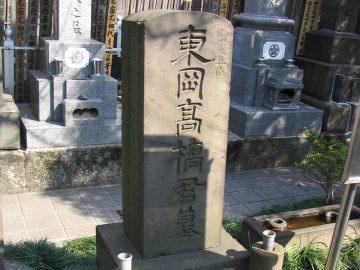
04. Tomb of Takahashi Yoshitoki
National Historic Site
Genku-ji Temple, 6 chome 18, Higashi-ueno
Takahashi Yoshitoki was born in Osaka in 1764 and became a famous astronomer in the latter half of the 18th century. He was appointed to "TENMONGATA" of the Shogunate Government at Edo, which was a post supervising astronomy, calendar making, and land surveying. He was the central figure in a calendar improvement project initiated as the time. He guided Ino Tadataka in surveying and assisted in producing a map of Japan using actual surveys. They wire later known as the forefathers of Japanese map-making. Takahashi died at the age of 41 in 1804.
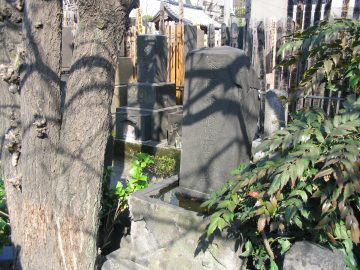
05. Tomb of Tani Buncho
Metropolitan Historic Site
Genku-ji Temple, 6 chome 18, Higashi-ueno
Tani Buncho was a painter, who painted in the style of the southern Chinese school. His father was Tani Rokoku, a Chinese style poet and a vassal of the Tayasu family.
He studied painting of the Yuan (Mongol) dynasty, Ming dynasty, and Ching dynasty in China, Kano school and Tosa school in Japan, the southern Chinese school at painting, and that of various schools of Europe and developed his unique painting style. He became a prominent figure in the world of Edo’s southern school of Chinese painting in contrast to the Kansai's southern Chinese school of painting. Watanabe Kazan, Tachihara Kyosho, Takaku Aigai were his pupils. His wife and daughter were also painters.
After he had travelled around Japan accompanying Matsudaira Sadanobu, a member of Shogun's Council, he produced the illustrations for "Shukojisshu." Beside this, his works are "Meisanzue", "Honchogasan", "Kouyotanshozu" (an important cultural property), etc., and he was good at painting people, landscapes, flowers and birds, insects and fish. His forte, however, was landscape painting.
He passed away at the age of 78 on the 14th of December 1840.
His tomb was designated as a metropolitan historical site in 1927.

06. Tomb of Banzuiin Chobee
Metropolitan Historic Site
Genku-ji Temple, 6 chome 18, Higashi-ueno
Chobee was a Machiyakko (a man of chivalrous spirit) early in the Edo Period. His real name was Tsukamoto Itaro. He was a samurai from Hizenkaratsu (Nagasaki Prefecture) and privately apprenticed himself to the chief priest of the temple Banzuiin. He was said to have lived at Asakusa Hanakawado and worked in an employment agency.
In those days there were many Yakko (gallants) rampant along the streets: there were two kinds: Machiyakko and Hatamotoyakko. The latter were from the retainer families of Shogun and the former with other roots. Chobee became the head of Machiyakko and competed with Mizuno Jurozaemon, the head of Hatamotoyakko. The details of their competition were not clear because they are full of legendary events and embroidered stories created by the people of coming ages.
He was led into a trap and killed by Mizuno Jurozaemon on the 13th of April 1650.
His tomb was designated as a metropolitan historical site in 1927.
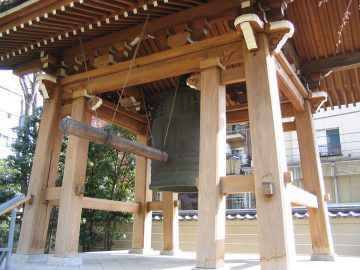
07. Copper Bell
Taito City Tangible Cultural Property
Genku-ji Temple, 6 chome 18, Higashi-ueno
Genku-ji Temple was opened in 1604 and transferred to its current location after being severely damaged in the great fire of 1657.
The copper bell of the present temple has a total height of 2.22 meters and is considered to be relatively large for copper bells produced between the 17th and 19th centuries. Genku-ji Temple cast the bell in 1636 upon the request of the third Tokugawa shogun, Tokugawa Iemitsu. The posthumous Buddhist names of the founder of the Edo Bakufu, Tokugawa Ieyasu, and his successor, Tokugawa Hidetada, as well as the third shogun Iemitsus official governing name are inscribed on its surface.
The artist responsible for making the bell was Shiina Yoshisada from the eminent Edo Period foundry of Shiina.

08. Copper Bell
Taito City Tangible Cultural Property
Houon-ji Temple, 6 chome 13-13, Higashi-ueno
This temple, widely known as Bando Houon-ji Temple, was established by Shoshin in 1214. It was originally located at Joso City in Ibaraki Prefecture, then moved to Edo in 1602. Its location was changed three times within Edo, finally settled here. This copper bell was cast in 1648 by Hori Joho, first-class craftsman of the period.
Other works by Hori Joho that remain today include copper lanterns at Nikko Toshogu Shrine and Ueno Toshogu Shrine.
It was registered as a tangible cultural asset in 1996 in the Book of Cultural Assets of Taito City.















